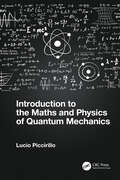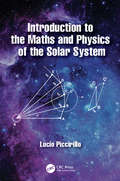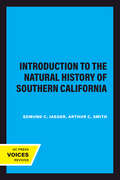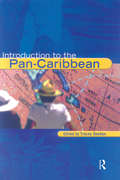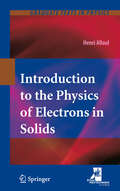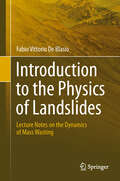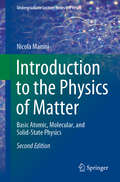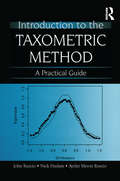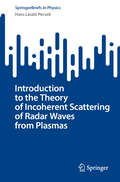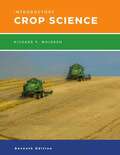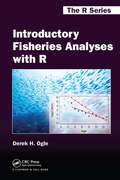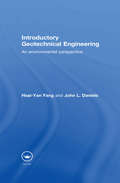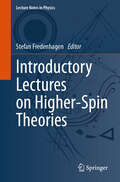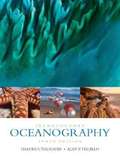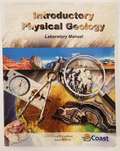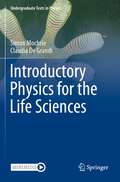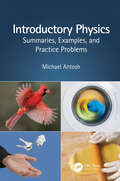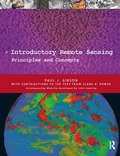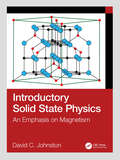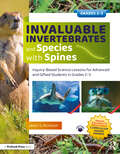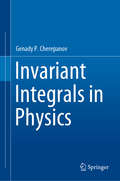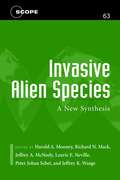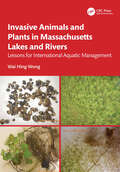- Table View
- List View
Introduction to the Maths and Physics of Quantum Mechanics
by Lucio PiccirilloIntroduction to the Maths and Physics of Quantum Mechanics details the mathematics and physics that are needed to learn the principles of quantum mechanics. It provides an accessible treatment of how to use quantum mechanics and why it is so successful in explaining natural phenomena. This book clarifies various aspects of quantum physics such as ‘why quantum mechanics equations contain “I”, the imaginary number?’, ‘Is it possible to make a transition from classical mechanics to quantum physics without using postulates?’ and ‘What is the origin of the uncertainty principle?’. A significant proportion of discussion is dedicated to the issue of why the wave function must be complex to properly describe our “real” world. The book also addresses the different formulations of quantum mechanics. A relatively simple introductory treatment is given for the “standard” Heisenberg matrix formulation and Schrodinger wave-function formulation and Feynman path integrals and second quantization are then discussed. This book will appeal to first- and second-year university students in physics, mathematics, engineering and other sciences studying quantum mechanics who will find material and clarifications not easily found in other textbooks. It will also appeal to self-taught readers with a genuine interest in modern physics who are willing to examine the mathematics and physics in a simple but rigorous way. Key Features: • Written in an engaging and approachable manner, with fully explained mathematics and physics concepts. <p class="MsoListParagraphCxSpMiddle" style="text-in
Introduction to the Maths and Physics of the Solar System
by Lucio PiccirilloThis book provides readers with an understanding of the basic physics and mathematics that governs our solar system. It explores the mechanics of our Sun and planets; their orbits, tides, eclipses and many other fascinating phenomena. This book is a valuable resource for undergraduate students studying astronomy and should be used in conjunction with other introductory astronomy textbooks in the field to provide additional learning opportunities. Features: Written in an engaging and approachable manner, with fully explained mathematics and physics concepts Suitable as a companion to all introductory astronomy textbooks Accessible to a general audience
Introduction to the Natural History of Southern California (California Natural History Guides #13)
by Edmund C. Jaeger Arthur C. SmithThis title is part of UC Press's Voices Revived program, which commemorates University of California Press’s mission to seek out and cultivate the brightest minds and give them voice, reach, and impact. Drawing on a backlist dating to 1893, Voices Revived makes high-quality, peer-reviewed scholarship accessible once again using print-on-demand technology. This title was originally published in 1966.This title is part of UC Press's Voices Revived program, which commemorates University of California Press’s mission to seek out and cultivate the brightest minds and give them voice, reach, and impact. Drawing on a backlist dating to 1893, Voices Revived</DIV
Introduction to the Pan-Caribbean
by Tracey SkeltonWith its diverse histories of slavery, plantations, colonialism and independence, the Caribbean is richly layered, highly complex and a wonderful example of people's resistance. The pan-Caribbean region also provides an excellent geography through which to understand and analyse the complex processes of globalisation, development, migration, tourism, and social and cultural relations. While the sea, sun and sand representation is a true one -some of the most beautiful places on earth are found in the Caribbean - the pan-Caribbean is much more intricate and fascinating than that. Where else in the world do French, Spanish, Dutch and English-speaking worlds co-exist alongside indigenous peoples and cultures? Where else have cultures of carnival, music and dance become so integrated into national and regional identities? The Caribbean is a crucible of diversity and semblance and a space that is both contradictory and harmonious.Introduction to the Pan-Caribbean has been written by people who are either from the region or have spent much of their working lives there. It is an excellent introduction and is your map through one of the most extraordinary and remarkable parts of the world.
Introduction to the Physical and Biological Oceanography of Shelf Seas
by John H. Simpson Jonathan SharplesIn this exciting and innovative textbook, two leading oceanographers bring together the fundamental physics and biology of the coastal ocean in a quantitative but accessible way for undergraduate and graduate students. Shelf sea processes are comprehensively explained from first principles using an integrated approach to oceanography that helps build a clear understanding of how shelf sea physics underpins key biological processes in these environmentally sensitive regions. Using many observational and model examples, worked problems and software tools, the authors explain the range of physical controls on primary biological production and shelf sea ecosystems. Boxes throughout the book present extra detail for each topic and non-mathematical summary points are provided for physics sections, allowing students to develop an intuitive understanding. The book is fully supported by extensive online materials, including worked solutions to end-of-chapter exercises, additional homework/exam problems with solutions and simple MATLAB and FORTRAN models for running simulations.
Introduction to the Physics of Electrons in Solids
by Henri Alloul Stephen LyleThis textbook sets out to enable readers to understand fundamental aspects underlying quantum macroscopic phenomena in solids, primarily through the modern experimental techniques and results. The classic independent-electrons approach for describing the electronic structure in terms of energy bands helps explain the occurrence of metals, insulators and semiconductors. It is underlined that superconductivity and magnetism can only be understood by taking into account the interactions between electrons. The text recounts the experimental observations that have revealed the main properties of the superconductors and were essential to track its physical origin. While fundamental concepts are underlined, those which are required to describe the high technology applications, present or future, are emphasized as well. Problem sets involve experimental approaches and tools which support a practical understanding of the materials and their behaviour.
Introduction to the Physics of Landslides
by Fabio Vittorio BlasioLandslides represent one of the most destructive natural catastrophes. They can reach extremely long distances and velocities, and are capable of wiping out human communities and settlements. Yet landslides have a creative facet as they contribute to the modification of the landscape. They are the consequence of the gravity pull jointly with the tectonic disturbance of our living planet. Landslides are most often studied within a geotechnical and geomorphological perspective. Engineering calculations are traditionally applied to the stability of terrains. In this book, landslides are viewed as a physical phenomenon. A physical understanding of landslides is a basis for modeling and mitigation and for understanding their flow behavior and dynamics. We still know relatively little about many aspects of landslide physics. It is only recently that the field of landslide dynamics is approaching a more mature stage. This is testified by the release of modelling tools for the simulation of landslides and debris flows. In this book the emphasis is placed on the problems at the frontier of landslide research. Each chapter is self-consistent, with questions and arguments introduced from the beginning.
Introduction to the Physics of Matter: Basic Atomic, Molecular, and Solid-State Physics (Undergraduate Lecture Notes in Physics)
by Nicola ManiniThis is the second edition of a well-received book. It provides an up-to-date, concise review of essential topics in the physics of matter, from atoms and molecules to solids, including elements of statistical mechanics. It features over 160 completely revised and enhanced figures illustrating the main physical concepts and the fundamental experimental facts, and discusses selected experiments, mainly in spectroscopy and thermodynamics, within the general framework of the adiabatic separation of the motions of electrons and nuclei. The book focuses on what can be described in terms of independent-particle models, providing the mathematical derivations in sufficient detail for readers to grasp the relevant physics involved. The final section offers a glimpse of more advanced topics, including magnetism and superconductivity, sparking readers’ curiosity to further explore the latest developments in the physics of matter.
Introduction to the Taxometric Method: A Practical Guide
by Nick Haslam John Ruscio Ayelet Meron RuscioIntroduction to the Taxometric Method is a user-friendly, practical guide to taxometric research. Drawing from both classic and contemporary research, it provides a comprehensive introduction to the method. With helpful tools and guidance, the book is intended to teach those new to the method, as well as those already familiar with it, tips on how to conduct and evaluate taxometric investigations. The book covers a broad range of analytic techniques, describing their logic and implementation as well as what is known about their performance from systematic study. The book opens with the background material essential to understanding the research problems that the taxometric method addresses. The authors then explain the data requirements of taxometric analysis, the logic of each procedure, factors that can influence results and lead to misinterpretations, suggestions for choosing the best procedures, and methodological safeguards to prevent erroneous conclusions. Illustrative examples of each procedure and consistency test demonstrate how to perform analyses and interpret results using a variety of data sets. A checklist of conceptual and methodological issues that should be addressed in any investigation is included. The downloadable resources provide a variety of programs for performing taxometric analyses along with simulations and analyses of data sets. Introduction to the Taxometric Method is ideal for researchers and students conducting or evaluating taxometric studies in the social and behavioral sciences, especially those in clinical and personality psychology, as well as those in the physical sciences, education, biology, and beyond. The book also serves as a text for courses on this method, or as a supplement in psychological assessment, statistics, or research methods courses. Familiarity with taxometrics is not assumed.
Introduction to the Theory of Incoherent Scattering of Radar Waves from Plasmas (SpringerBriefs in Physics)
by Hans László PécseliThis book introduces the theory behind the incoherent scattering of electromagnetic waves (radar waves) by free electrons—a key technique for studying critical parameters of the Earth&’s ionosphere. Starting with scattering by statistically independent electrons, including magnetized cases, the book progressively develops a comprehensive model. This framework is extended to include &‘dressed particles&’, accounting for long-range Coulomb interactions between charged particles. A consistent approach to incorporating particle collisions is presented, with an example of charge exchange interactions for illustration. Appendices provide essential background material, ensuring the content is accessible to readers. Based on lectures delivered at the University of Tromsø, Norway, this book is designed for Masters and PhD students. It assumes a basic understanding of electromagnetism and plasma physics, including plasma waves and electrostatic phenomena. Familiarity with kinetic plasma theory and the collisionless Vlasov equation is beneficial but not mandatory.
Introductory Fisheries Analyses with R (Chapman & Hall/CRC The R Series #32)
by Derek H. OgleA How-To Guide for Conducting Common Fisheries-Related Analyses in R Introductory Fisheries Analyses with R provides detailed instructions on performing basic fisheries stock assessment analyses in the R environment. Accessible to practicing fisheries scientists as well as advanced undergraduate and graduate students, the book demonstrates the flexibility and power of R, offers insight into the reproducibility of script-based analyses, and shows how the use of R leads to more efficient and productive work in fisheries science. The first three chapters present a minimal introduction to the R environment that builds a foundation for the fisheries-specific analyses in the remainder of the book. These chapters help you become familiar with R for basic fisheries analyses and graphics. Subsequent chapters focus on methods to analyze age comparisons, age-length keys, size structure, weight-length relationships, condition, abundance (from capture-recapture and depletion data), mortality rates, individual growth, and the stock-recruit relationship. The fundamental statistical methods of linear regression, analysis of variance (ANOVA), and nonlinear regression are demonstrated within the contexts of these common fisheries analyses. For each analysis, the author completely explains the R functions and provides sufficient background information so that you can confidently implement each method. Web Resource The author’s website at http://derekogle.com/IFAR/ includes the data files and R code for each chapter, enabling you to reproduce the results in the book as well as create your own scripts. The site also offers supplemental code for more advanced analyses and practice exercises for every chapter.
Introductory Geotechnical Engineering: An Environmental Perspective
by Hsai-Yang Fang John L. DanielsIntegrating and blending traditional theory with particle-energy-field theory, this book provides a framework for the analysis of soil behaviour under varied environmental conditions. This book explains the why and how of geotechnical engineering in an environmental context. Using both SI and Imperial units, the authors cover: rock mechanics soil mechanics and hydrogeology soil properties and classifications and issues relating to contaminated land. Students of civil, geotechnical and environmental engineering and practitioners unfamiliar with the particle-energy-field concept, will find that this book's novel approach helps to clarify the complex theory behind geotechnics.
Introductory Lectures on Higher-Spin Theories (Lecture Notes in Physics #1028)
by Stefan FredenhagenThe book offers a pedagogical introduction to higher-spin gauge theories. These theories build upon fundamental gauge theories that are crucial for understanding core interactions. Electromagnetism and nuclear forces are associated with gauge fields of spin 1, while gravity can be conceptualized as a gauge theory of spin 2. This prompts the intriguing inquiry: do higher-spin gauge theories exist? Such theories would extend gravity, incorporating massless gauge fields of spins higher than two. They appear to bear connections to string theory and offer a captivating framework for exploring gravity and aspects of quantum gravity. The book initiates with a primer offering a comprehensive discussion on higher spins, delving into the challenges of establishing coherent interactions. It then explores methodologies to surmount these challenges within three-dimensional space-time. Furthermore, it investigates the emergence of asymptotic symmetry algebras, establishing links to a holographic dual conformal theory. The final chapter introduces Vasiliev’s approach to higher-spin gauge theory in four dimensions. Designed for advanced students and young researchers in theoretical physics and mathematical physics, the book aims to elucidate fundamental ideas, concepts, and tools underpinning higher-spin gauge theories. The inclusion of numerous exercises complements and illustrates the content, preparing readers for engagement with the subject's original literature and ongoing developments. To fully engage with the book's arguments, a prerequisite understanding of field theories and conventional gauge theories, including gravity, is assumed.
Introductory Oceanography
by Harold V. Thurman Alan P. TrujilloThis book is intended to help students in their quest to find out more about oceans. Because of its comprehensive scope and excellent resource materials, it can also serve as an excellent reference work for those involved in oceanography.
Introductory Physical Geology: Laboratory Manual
by Greg P. Gardiner Susan WillcoxThe laboratory kit and manual are part of an intensive laboratory course that explores the basic concepts and principles of physical geology. The kit is designed to be used in all delivery modalities. <p><p> The 14 lessons follow a sequence that progresses through the basics of plate tectonics, seismology, minerals and rocks, and geologic time and concludes with overarching topics such as Earth's major geologic features and economic geology resources. <p> Students will be able to effectively apply concepts, principles, and theories of physical geology to make accurate observations and identify samples, structures, and landscapes. They will also analyze data, formulate and test hypotheses, solve problems, and come to supportable conclusions given various scenarios and research topics.
Introductory Physics for the Life Sciences (Undergraduate Texts in Physics)
by Simon Mochrie Claudia De GrandiThis classroom-tested textbook is an innovative, comprehensive, and forward-looking introductory undergraduate physics course. While it clearly explains physical principles and equips the student with a full range of quantitative tools and methods, the material is firmly grounded in biological relevance and is brought to life with plenty of biological examples throughout.It is designed to be a self-contained text for a two-semester sequence of introductory physics for biology and premedical students, covering kinematics and Newton’s laws, energy, probability, diffusion, rates of change, statistical mechanics, fluids, vibrations, waves, electromagnetism, and optics. Each chapter begins with learning goals, and concludes with a summary of core competencies, allowing for seamless incorporation into the classroom. In addition, each chapter is replete with a wide selection of creative and often surprising examples, activities, computational tasks, and exercises, many of which are inspired by current research topics, making cutting-edge biological physics accessible to the student.
Introductory Physics: Summaries, Examples, and Practice Problems
by Michael AntoshPhysics describes how motion works in everyday life. Clothes washers and rolling pins are undergoing rotational motion. A flying bird uses forces. Tossing a set of keys involves equations that describe motion (kinematics). Two people bumping into each other while cooking in a kitchen involves linear momentum. This textbook covers topics related to units, kinematics, forces, energy, momentum, circular and rotational motion, Newton’s general equation for gravity, and simple harmonic motion (things that go back and forth). A math review is also included, with a focus on algebra and trigonometry. The goal of this textbook is to present a clear introduction to these topics, in small pieces, with examples that readers can relate to. Each topic comes with a short summary, a fully solved example, and practice problems. Full solutions are included for over 400 problems. This book is a very useful study guide for students in introductory physics courses, including high school and college students in an algebra-based introductory physics course and even students in an introductory calculus-level course. It can also be used as a standalone textbook in courses where derivations are not emphasized.
Introductory Remote Sensing Principles and Concepts
by Paul Gibson With contributions from Clare PowerIntroduction to Remote Sensing: Digital Image Processing and Applications presents a unique textbook/downloadable resources package. It explains how digital images can be processed and offers practical hands-on experience of image processing. This package, which is ideal for student self-study, institutional or library purchase, shows how digital images can be processed to maximize information output and discusses a range of environmental monitoring techniques. A range of case studies are explored, drawn from a variety of disciplines and from across the world. The book also includes a practical manual of image processing instruction and detailed practical exercises to support the unique downloadable resources which accompanies the book.The downloadable resources contain fully functioning image processing software - a limited edition of DRAGON software developed specifically for readers of Introductory Remote Sensing - and over 70 satellite digital datasets for 9 scenes across America, Ireland, China, Sudan, Peru, Western Europe and the UK.
Introductory Solid State Physics: An Emphasis on Magnetism
by David C. JohnstonIntroductory Solid State Physics: An Emphasis on Magnetism acts as a supplement to students tackling solid state physics at both the undergraduate and graduate level. The BCS theory of superconductivity is not included in undergraduate-level books, because the theory is derived at the graduate level. However, this book uses the equations derived by BCS to calculate the thermodynamic properties of superconductors such as the temperature dependence of the heat capacity using techniques accessible to undergraduates. Also covering topics such as wave diffraction, the essentials of thermodynamics, statistical mechanics and local-moment magnetism, it is useful for those studying solid state physics at any level.Key Features: Includes the BCS theory of superconductivity Provides material that is accessible to students at all levels Approaches the subject with a particular emphasis on magnetism
Invaluable Invertebrates and Species with Spines: Inquiry-Based Science Lessons for Advanced and Gifted Students in Grades 2-3
by Jason S. McIntoshRecipient of the 2022 NAGC Curriculum AwardInspire the next generation of zoologists with this 30-lesson interdisciplinary science unit geared toward second and third grade high-ability students.Using problem-based learning scenarios, this book helps students develop the vocabulary, skills, and practices of zoologists as they conduct research and solve real world problems. Students will gain an in-depth understanding of how the animal kingdom is structured, create an innovative zoo exhibit containing an entire ecosystem for a vertebrate animal of their choosing, design invertebrate animal trading cards, and much, much more. Featuring detailed teacher instructions and reproducible handouts, this unit makes it easy for teachers to adjust the rigor of learning tasks based on students’ interests and needs.Aligned with Common Core State Standards for English Language Arts and Mathematics plus the Next Generation Science Standards, gifted and non-gifted teachers alike will find this expedition into the animal kingdom engaging, effective, and highly adaptable.
Invariant Integrals in Physics
by Genady P. CherepanovIn this book, all physical laws are derived from a small number of invariant integrals which express the conservation of energy, mass, or momentum. This new approach allows us to unify the laws of theoretical physics, to simplify their derivation, and to discover some novel or more universal laws. Newton's Law of gravity is generalized to take into account cosmic forces of repulsion, Archimedes' principle of buoyancy is modified for account of the surface tension, and Coulomb's Laws for rolling friction and for the interaction of electric charges are substantially repaired and generalized. For postgraduate students, lecturers and researchers.
Invasion Biology and Ecological Theory
by Herbert H. T. Prins Iain J. Gordon Herbert H. T. Prins Iain J. GordonMany conservationists argue that invasive species form one of the most important threats to ecosystems the world over, often spreading quickly through their new environments and jeopardising the conservation of native species. As such, it is important that reliable predictions can be made regarding the effects of new species on particular habitats. This book provides a critical appraisal of ecosystem theory using case studies of biological invasions in Australasia. Each chapter is built around a set of 11 central hypotheses from community ecology, which were mainly developed in North American or European contexts. The authors examine the hypotheses in the light of evidence from their particular species, testing their power in explaining the success or failure of invasion and accepting or rejecting each hypothesis as appropriate. The conclusions have far-reaching consequences for the utility of community ecology, suggesting a rejection of its predictive powers and a positive reappraisal of natural history.
Invasive Alien Species: A New Synthesis (SCOPE Series #63)
by Harold A. Mooney Laurie E. Neville Jeffrey A. Mcneely Richard Mack Jeffrey K. Waage Peter Johan ScheiInvasive alien species are among today's most daunting environmental threats, costing billions of dollars in economic damages and wreaking havoc on ecosystems around the world. In 1997, a consortium of scientific organizations including SCOPE, IUCN, and CABI developed the Global Invasive Species Programme (GISP) with the explicit objective of providing new tools for understanding and coping with invasive alien species.Invasive Alien Species is the final report of GISP's first phase of operation, 1997-2000, in which authorities from more than thirty countries worked to examine invasions as a worldwide environmental hazard. The book brings together the world's leading scientists and researchers involved with invasive alien species to offer a comprehensive summary and synthesis of the current state of knowledge on the subject. Invasive alien species represent a critical threat to natural ecosystems and native biodiversity, as well as to human economic vitality and health. The knowledge gained to date in understanding and combating invasive alien species can form a useful basis on which to build strategies for controlling or minimizing the effects in the future. Invasive Alien Species is an essential reference for the international community of investigators concerned with biological invasions.
Invasive Animals and Plants in Massachusetts Lakes and Rivers: Lessons for International Aquatic Management
by Wai Hing WongThere is a growing demand for appropriate management of aquatic invasive species in lakes and rivers worldwide. This book covers biology, invasion ecology, sightings, and control techniques of 4 invasive animals and 15 invasive plants in Massachusetts lakes and rivers. It provides valuable information on their biological characteristics and potential expansion pathways, as well as monitoring and management, including alternative management tools using updated biological, chemical, and mechanical methods. The book also includes the regulation of invasive species management to allow resource managers, biologists, practitioners, volunteers, and students a better understanding of compliance and enforcement with environmental law. An example of successful management is highlighted for each invasive species. Invasive Animals and Plants in Massachusetts Lakes and Rivers is the first book to provide comprehensive and systematic coverage and illustrations for both freshwater invasive animals and plants. Although focussing on Massachusetts, it will provide readers with the bigger picture on multiple invasive species, from prevention, early detection, control, ecological restoration, to public education. Natural resource managers in Massachusetts and surrounding states will glean the detailed and valuable information they need to learn and use to prevent and manage freshwater invasive species in the field.
